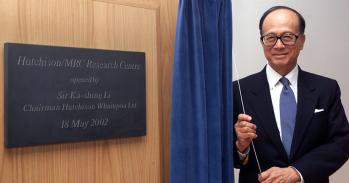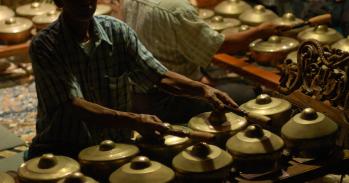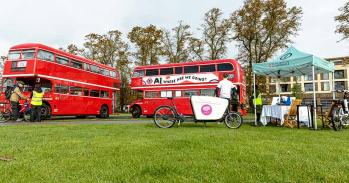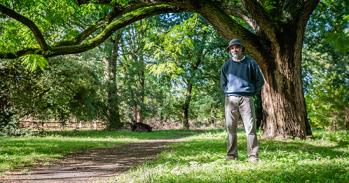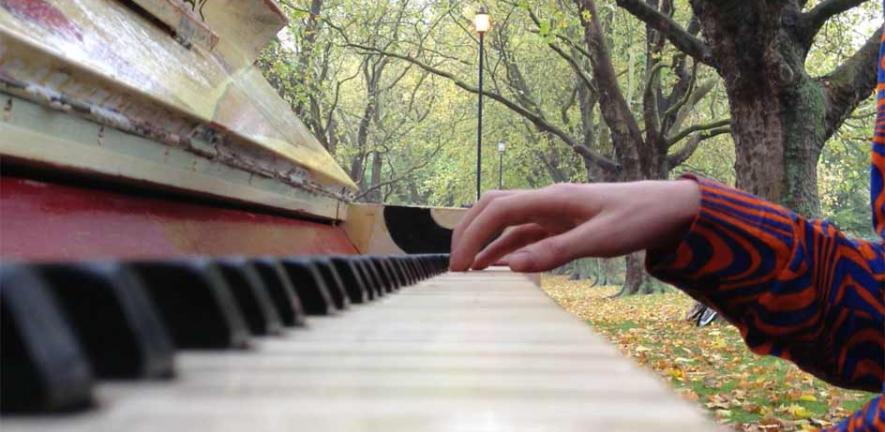
A city-wide public art installation of fifteen painted pianos will be placed on Cambridge streets for two weeks, as part of the University’s Festival of Ideas. Decorated by local artists and charities, the art invites the community to make music together.
A city-wide public art installation of fifteen painted pianos will be placed on Cambridge streets for two weeks, as part of the University’s Festival of Ideas. Decorated by local artists and charities, the art invites the community to make music together.
The beauty of a piano is that anyone can sit down, press a key and make a noise. I want everyone to give it a go!
Ruth Hardie
For two weeks, from Monday 22 October, fifteen pianos destined for the scrap heap have been given a new lease of life - as public art. Revived by the Faculty of Music for the University’s Festival of Ideas, and decorated by local artists and charities, the pianos have been placed in communal spaces around the city as an open invitation to anyone and everyone who fancies tinkling the ivories.
The University’s Faculty of Music are presenting a Cambridge stage of the artist Luke Jerram’s global street piano project Play Me, I’m Yours for the Festival of Ideas. Initially launched in London in 2008, the public artwork project has now reached over two million people worldwide – more than 700 pianos have already been installed in cities across the globe, from New York to Sydney.
A total of fifteen pianos have been installed right across the city, from the world famous centre to some of the city’s outlying communities.
One piano is sneaking into tourist snaps outside the University’s Senate House, while the sound of public music-making drifts across the Mill pond from another on Silver Street bridge.
But pianos have also been located in the heart of Cambridge communities, with a piano in local shopping precinct Arbury Court, another entertaining dog-walkers’ at Cherry Hinton Hall, and even one outside legendary local venue The Junction - giving punters the opportunity for impromptu post-gig jamming.
Ruth Hardie, Outreach Officer at the Faculty of Music, has been instrumental in bringing Jerram’s vision to Cambridge for the Festival of Ideas. For Hardie, accessible community art is not just a job but a passion.
“It is so important to me that public art brings something engaging to the community, and this project does just that” said Hardie. “The University has so many resources in terms of brains and enthusiasm - I love being able to share that with the local community. But it’s not just a one way process, the University can learn a lot from the community too.”
“I hope this project will get people not just playing together but talking to each other. It’s very easy to see the same faces day in day out and never strike up a conversation.”
Hardie is keen to stress that it’s not just for the people who can play really well. “The beauty of a piano is that anyone can sit down, press a key and make a noise. I want everyone to give it a go!” Newcomers can come along to some of the piano sites on Saturday 27 October for a free piano lesson to get them started, for more information see the website www.camstreetpianos.co.uk. People are encouraged to share their comments, videos and photos on the website.
Each piano has a designated ‘buddy’ in the area, either from local businesses or area residents, who have volunteered to check in on the instrument and lock it up at night for safety reasons where necessary.
The pianos have been decorated by a range of Cambridge artists and charities, all around the Festival’s theme of ‘dreams and nightmares’. Local graffiti collective the Blight Society have sprayed some of the pianos, while students from Anglia Ruskin’s Illustration and Fine Art degree courses have revamped others. Even members of the Faculty of Music itself, used to creating aural rather than visual delights, are trying their hand at painting.
“It was great to be asked to be a part of this project, this is a really accessible public art project and public art should be accessible. Spray paint as a medium is big, fast and cheap - perfect for engaging public art applications,” said Jon Bates, who runs the Blight Society.
A timelapse film of Blight Society artists painting their pianos
One of the pianos has been painted by local charity FLACK, a social enterprise whose homeless members contribute to the production of a monthly magazine. For FLACK’s members, the location of their piano on Midsummer Common is an important one, as it is common, public land.
“This project has been a great opportunity for us to show the talent of our members,” said Kirsten Lavers, FLACK’s creative director. “They’re really keen that people recognise homeless people are creative, skilled and have ideas.”
Other local charities involved include the Women’s Resource Centre Art Group and arts and disability charity ROWAN.
One of the pianos is so beautifully carved, Hardie couldn’t bring herself to give it the radical new look of the others. “I couldn’t even put it outside, so it’s going in the Grand Arcade,” she said. Piano tuner and repairman David Lock, believes it to be an overstrung, underdamper upright built by a maker in Leipzig, possibly circa 1890.
“Chances are the cabinet was specially commissioned to match existing furniture. The piano was probably passed down through a family until someone died and bequeathed the instrument to a school,” said Lock. “It’s an amazing piece of furniture.”
The artist and original conceiver of the Play Me, I’m Yours project, Luke Jerram, was in Cambridge on the first day of the two-week stint to see the art in situ.
“The idea for Play Me, I’m Yours came from visiting my local launderette. I saw the same people there each weekend and yet no one talked to one another,” said Jerram.
“I suddenly realised that within a city, there must be hundreds of these invisible communities, regularly spending time with one another in silence. Placing a piano into the space was my solution to this problem, acting as a catalyst for conversation and changing the dynamics of a space.”
“I’ve been overwhelmed by the local support,” adds Hardie. “Butler Smith Specialist Carrier, Miller’s Music and David Lock have done a brilliant job and Cambridgeshire Community repaint have been very generous, as have a number of financial donors. Not to mention the hours of time artists and community groups have dedicated to designing and decorating their pianos and the local buddies who have volunteered.”
“If you don’t provide people with opportunities then they never have the chance to show how much they value those opportunities. I want people to see the invitation ‘Play me, I’m yours’ and do just that.”
This work is licensed under a Creative Commons Licence. If you use this content on your site please link back to this page.


